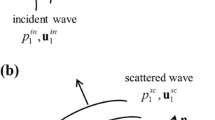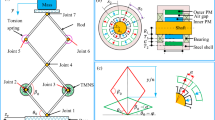Abstract
Herein a vibration test method is discussed based on a non-contact, non-destructive excitation input using a laser-induced plasma (LIP) shock wave and a non-contact input estimation using Newton’s second law of motion. We have previously introduced a non-contact vibration test method using an excitation force generated by laser ablation, but it cannot be used when the target structure is lightweight, fragile, and small-sized because a crater with a diameter of several micrometers is created. The LIP generates a highly reproducible shock wave, which become an excitation force to a target structure. This shock wave depends on the gas density, gas specific heat ratio, laser fluence, and ambient environment. If these parameters are constant, the LIP excitation force can be estimated beforehand, allowing only the output measurement to determine the frequency response measurement of an input–output relationship of the target structure. After calibrating the LIP excitation, the frequency response function of a target structure can be obtained.









Similar content being viewed by others
References
Wu B (2008) High-intensity nanosecond-pulsed laser-induced plasma in air, water, and vacuum: a comparative study of the early-stage evolution using a physics-based predictive model. Appl Phys Lett 93:101104. doi:10.1063/1.2979704
Kawahara N, Beduneau JL, Nakayama T, Tomita E, Ikeda Y (2007) Spatially, temporally, and spectrally resolved measurement of laser-induced plasma in air. Appl Phys B 86:605–614. doi:10.1007/s00340-006-2531-4
Pandey PK, Gupta SL, Narayanan V, Thareja RK (2012) Air plasma waveguide using pico-sec and nano-sec laser pulses. Phys Plasmas 19:023502. doi:10.1063/1.3676617
Hu W, Shin YC, King G (2011) Effect of air breakdown with a focusing lens on ultrashort laser ablation. Appl Phys Lett 99:234104. doi:10.1063/1.3665631
Oksanen M, Hietanen J (1994) Photoacoustic breakdown sound source in air. Ultrasonics 32:327–331. doi:10.1016/0041-624X(94)90102-3
Qin Q, Attenborough K (2004) Characteristics and application of laser-generated acoustic shock waves in air. Appl Acoust 65:325–340. doi:10.1016/j.apacoust.2003.11.003
Hosoya N, Nagata M, Kajiwara I (2013) Acoustic testing in a very small space based on a point sound source generated by laser-induced breakdown: stabilization of plasma formation. J Sound Vib 332:4572–4583. doi:10.1016/j.jsv.2013.03.035
Georgiev VB, Krylov VV, Qin Q, Attenborough K (2011) Generation of flexural waves in plates by laser-initiated airborne shock waves. J Sound Vib 330:217–228. doi:10.1016/j.jsv.2010.08.005
Beduneau JL, Kim B, Zimmer L, Ikeda Y (2003) Measurements of minimum ignition energy in premixed laminar methane/air flow by using laser induced spark. Combus Flame 132:653–665. doi:10.1016/S0010-2180(02)00536-9
Bradley D, Sheppard CGW, Suardjaja IM, Woolley R (2004) Fundamentals of high-energy spark ignition with lasers. Combust Flame 138:55–77. doi:10.1016/j.combustflame.2004.04.002
Ferioli F, Buckley SG (2006) Measurements of hydrocarbons using laser-induced breakdown spectroscopy. Combust Flame 144:435–447. doi:10.1016/j.combustflame.2005.08.005
Zorba V, Syzdek J, Mao X, Russo RE, Kostecki R (2012) Ultrafast laser induced breakdown spectroscopy of electrode/electrolyte interfaces. Appl Phys Lett 100:234101. doi:10.1063/1.4724203
Petkovšek R, Horvat D, Močnik G, Terzić M, Možina J (2006) Analysis of optodynamic sources generated during laser-induced breakdown in water. Ultrasonics 44:1255–1258. doi:10.1016/j.ultras.2006.05.078
Huda F, Kajiwara I, Hosoya N (2014) Damage detection in membrane structures using non-contact laser excitation and wavelet transformation. J Sound Vib 333:3609–3624. doi:10.1016/j.jsv.2014.04.008
Zhang Y, Hiruta T, Kajiwara I, Hosoya N (2015) Active vibration suppression of membrane structures and evaluation with a non-contact laser excitation vibration test. J Vib Control. doi: 10.1177/1077546315599302
Bolaños JG, Delikaris-Manias S, Pulkki V, Eskelinen J, Hæggström E (2014) Laser-induced acoustic point source for accurate impulse response measurements within the audible bandwidth. J Acoust Soc Am 135:EL298–EL303. doi:10.1121/1.4879664
Bahr CJ, Zawodny NS, Bertolucci B, Li J, Sheplak M, Cattafesta LN (2015) A plasma-based non-intrusive point source for acoustic beamforming applications. J Sound Vib 344:59–80. doi:10.1016/j.jsv.2015.01.023
Champoux Y, Cotoni V, Paillard B, Beslin O (2003) Moment excitation of structures using two synchronized impact hammers. J Sound Vib 263:515–533. doi:10.1016/S0022-460X(02)01064-7
Elliott AS, Moorhouse AT, Pavić G (2012) Moment excitation and the measurement of moment mobilities. J Sound Vib 331:2499–2519. doi:10.1016/j.jsv.2012.01.022
Hosoya N, Yaginuma S, Onodera H, Yoshimura T (2015) Estimation of the auto frequency response function at unexcited points using dummy masses. J Sound Vib 337:14–27. doi:10.1016/j.jsv.2014.09.033
Hu H, Wang X, Zhai H, Zhang N, Wang P (2010) Generation of multiple stress waves in silica glass in high fluence femtosecond laser ablation. Appl Phys Lett 97:061117. doi:10.1063/1.3479919
Alfano M, Lubineau G, Furgiuele F, Paulino GH (2012) Study on the role of laser surface irradiation on damage and decohesion ofAl/ epoxy bonded joints. Int J Adhes Adhes 39:33–41. doi:10.1016/j.331ijadhadh.2012.03.002
Zhou Y, Tao S, Wu B (2011) Backward growth of plasma induced by long nanosecond laser pulse ablation. Appl Phys Lett 99:051106. doi:10.1063/1.3621855
Zeng X, Mao X, Mao SS, Wen SB, Greif R, Russo RE (2006) Laser-induced shockwave propagation from ablation in a cavity. Appl Phys Lett 88:061502. doi:10.1063/1.2172738
Sasaki K, Nakano T, Soliman W, Takada N (2009) Effect of pressurization on the dynamics of a cavitation bubble induced by liquid-phase laser ablation. Appl Phys Express 2:046501
Yabe T, Phipps C, Yamaguchi M, Nakagawa R, Aoki K, Mine H, Ogata Y, Baasandash C, Nakagawa M, Fujiwara E, Yoshida K, Nishiguchi A, Kajiwara I (2002) Microairplane propelled by laser driven exotic target. Appl Phys Lett 80(23):4318. doi:10.1063/1.1485313
Kamata M, Obara M, Gattass RR, Cerami LR, Mazur E (2005) Optical vibration sensor fabricated by femtosecond laser micromachining. Appl Phys Lett 87(5):051106. doi:10.1063/1.2008362
Qian F, Singh RK, Dutta SK, Pronko PP (1995) Laser deposition of diamondlike carbon films at high intensities. Appl Phys Lett 67(21):3120. doi:10.1063/1.114853
Hatamleh O (2008) Effects of peening on mechanical properties in friction stir welded 2195 aluminum alloy joints. Mat Sci Eng A-Struct 492:168–176. doi:10.1016/j.msea.2008.03.017
Kingstedt OT, Lambros J (2015) Ultra-high speed imaging of laser-induced spallation. Exp Mech 55:587–598. doi:10.1007/s11340-014-9973-0
Kajiwara I, Hosoya N (2011) Vibration testing based on impulse response excited by laser ablation. J Sound Vib 330:5045–5057. doi:10.1016/j.jsv.2010.09.036
Hosoya N, Kajiwara I, Hosokawa T (2012) Vibration testing based on impulse response excited by pulsed-laser ablation: Measurement of frequency response function with detection-free input. J Sound Vib 331:1355–1365. doi:10.1016/j.jsv.2011.10.034
Huda F, Kajiwara I, Hosoya N, Kawamura S (2013) Bolt loosening analysis and diagnosis by non-contact laser excitation vibration tests. Mech Syst Signal Process 40:589–604. doi:10.1016/j.ymssp.2013.05.023
Hosoya N, Kajiwara I, Umenai K (2015) Dynamic characterizations of underwater structures using non-contact vibration test based on nanosecond laser ablation in water: investigation of cavitation bubbles by visualizing shockwaves using the Schlieren method. J Vib Control. doi: 10.1177/1077546314564693
Hosoya N, Kajiwara I, Inoue T, Umenai K (2014) Non-contact acoustic tests based on nanosecond laser ablation: Generation of a pulse sound source with a small amplitude. J Sound Vib 333:4254–4264. doi:10.1016/j.jsv.2014.04.050
Hosoya N, Umino R, Kajiwara I, Maeda S, Onuma T, Mihara A (2016) Damage detection in transparent materials using non-contact laser excitation by nano-second laser ablation and high-speed polarization-imaging camera. Exp Mech 56:339–343. doi:10.1007/s11340-012-9646-9
Clorennec D, Prada C, Royer D, Murray TW (2006) Laser impulse generation and interferometer detection of zero group velocity Lamb mode resonance. Appl Phys Lett 89:024101. doi:10.1063/1.2220010
Sale M, Rizzo P, Marzani A (2011) Semi-analytical formulation for the guided waves-based reconstruction of elastic moduli. Mech Syst Signal Pr 25:2241–2256. doi:10.1016/j.ymssp.2011.02.004
Dhital D, Lee JR (2012) A fully non-contact ultrasonic propagation imaging system for closed surface crack evaluation. Exp Mech 52:1111–1122. doi:10.1007/s11340-011-9567-z
Balvantín A, Baltazar A, Rodriguez P (2014) Characterization of laser generated Lamb wave modes after interaction with a thickness reduction discontinuity using ray tracing theory. Exp Mech 54:743–752. doi:10.1007/s11340-013-9846-y
Liu P, Sohn H, Kundu T, Yang S (2014) Noncontact detection of fatigue cracks by laser nonlinear wave modulation spectroscopy (LNWMS). NDT&E Int 66:106–116. doi:10.1016/j.ndteint.2014.06.002
Acknowledgments
We thank the Japan Society for the Promotion of Science for their support under the Grants-in-Aid for Scientific Research programs (Grants-in-Aid for Scientific Research (B), Project No. 16H04291 and No. 16H04286, and Grant-in-Aid for Challenging Exploratory Research, Project No. 26630080). We would also like to thank Photron Limited for their assistance photographing plasma formation using their high-speed camera.
Author information
Authors and Affiliations
Corresponding author
Rights and permissions
About this article
Cite this article
Hosoya, N., Nagata, M., Kajiwara, I. et al. Nano-second Laser-induced Plasma Shock Wave in Air for Non-contact Vibration Tests. Exp Mech 56, 1305–1311 (2016). https://doi.org/10.1007/s11340-016-0167-9
Received:
Accepted:
Published:
Issue Date:
DOI: https://doi.org/10.1007/s11340-016-0167-9




